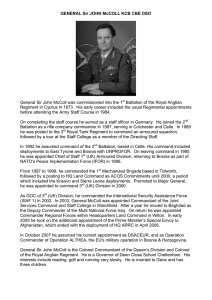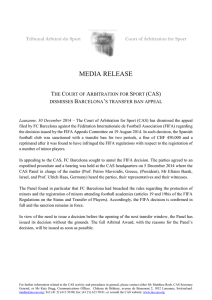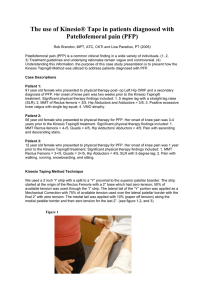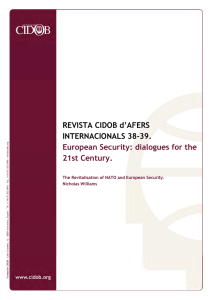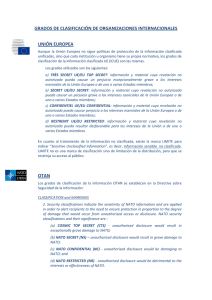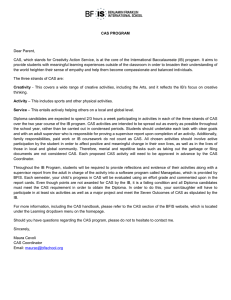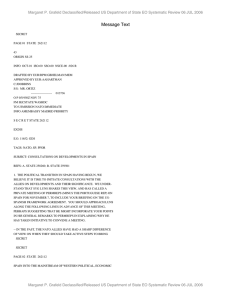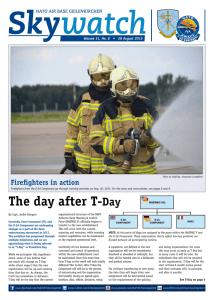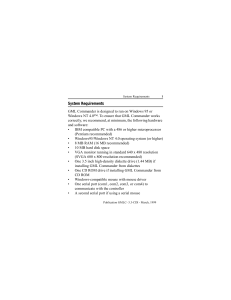ATP-27 (C) AJP-3.3.2 Air Interdiction and Close Air Support
Anuncio
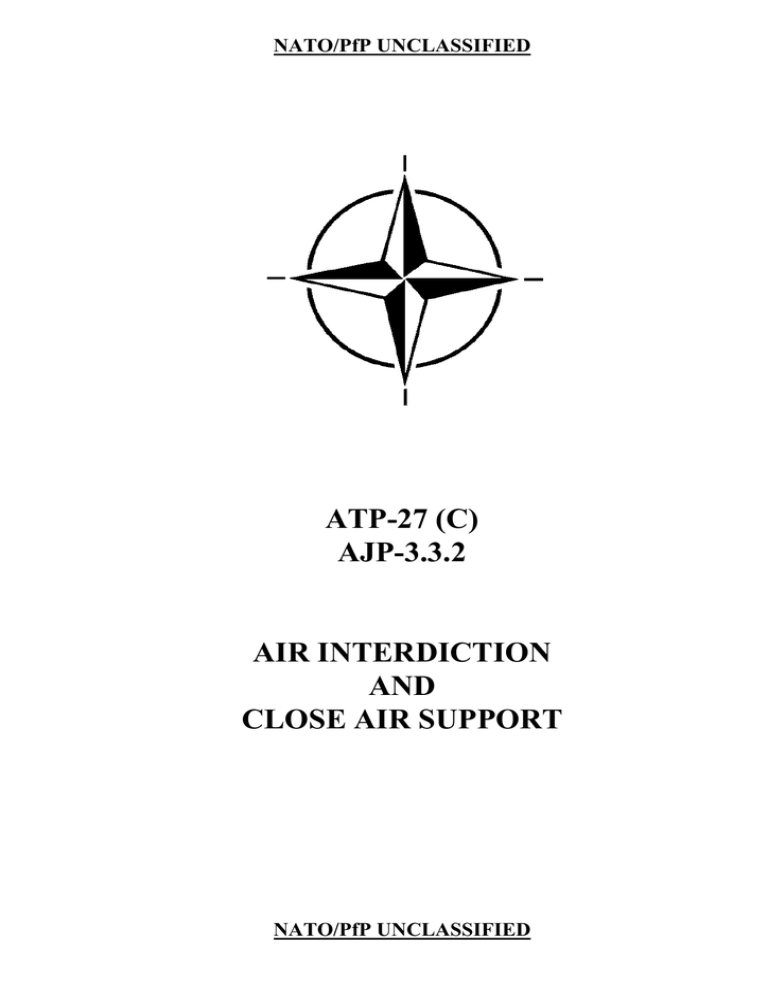
NATO/PfP UNCLASSIFIED ATP-27 (C) AJP-3.3.2 AIR INTERDICTION AND CLOSE AIR SUPPORT NATO/PfP UNCLASSIFIED NATO/PfP UNCLASSIFIED AJP-3.3.2/ ATP-27 (C) ATP-27 (C) AJP-3.3.2 AIR INTERDICTION AND CLOSE AIR SUPPORT June 1999 -IORIGINAL NATO/PfP UNCLASSIFIED NATO/PfP UNCLASSIFIED AJP-3.3.2/ ATP-27 (C) Feedback Any comments concerning this publication should be directed to: NATO/ MAS Bld Leopold III 1110 - Brussels, BE - II ORIGINAL NATO/PfP UNCLASSIFIED NATO/PfP UNCLASSIFIED AJP-3.3.2/ ATP-27 (C) NORTH ATLANTIC TREATY ORGANIZATION MILITARY AGENCY FOR STANDARDIZATION (MAS) NATO LETTER OF PROMULGATION June 1999 1. ATP-27 (C) - AIR INTERDICTION AND CLOSE AIR SUPPORT is a NATO UNCLASSIFIED publication. The agreement of nations to use this publication is recorded in STANAG 3736. 2. ATP-27 (C) is effective on a date to be promulgated by the Air Board, Military Agency for Standardization. When made effective it shall supersede ATP-27 (B) which shall be destroyed in accordance with the local procedure for the destruction of documents. A. GRØNHEIM Major General, NOAF Chairman MAS - III ORIGINAL NATO/PfP UNCLASSIFIED NATO/PfP UNCLASSIFIED AJP-3.3.2/ ATP-27 (C) ATP-27(C) AJP-3.3.2 AIR INTERDICTION AND CLOSE AIR SUPPORT Allied Tactical Publication-27(C) (ATP-27(C)) Air Interdiction and Close Air Support, which is effective on a date to be announced by The Air Board, Military Agency for Standardisation NATO Headquarters is promulgated: As directed by the Chiefs of Staff A A Milton Major General Director General Joint Doctrine and Concepts Ministry of Defence - IV ORIGINAL NATO/PfP UNCLASSIFIED NATO/PfP UNCLASSIFIED AJP-3.3.2/ ATP-27 (C) CHAPTER RECORD OF RESERVATION BY NATIONS 1 None 2 CA, SP 3 None 4 None 5 None Annex A None Annex B None -VORIGINAL NATO/PfP UNCLASSIFIED NATO/PfP UNCLASSIFIED AJP-3.3.2/ ATP-27 (C) NATION RESERVATIONS CA The definition of Fire Support Coordination Line (FSCL) found in ATP27 (C) was proposed by the MAS AOWG in May 1998. This definition was reviewed by the MAS ARTY WG in November 1998 and was not accepted. Until consensus is achieved, the primary definition of the FSCL should be considered as the one contained in the AAP-6, NATO Glossary of Terms and Definitions. SP Spain will participate with ADP formatted messages on a trial basis only until experience has been gained on practicability of the formats. - VI ORIGINAL NATO/PfP UNCLASSIFIED NATO/PfP UNCLASSIFIED AJP-3.3.2/ ATP-27 (C) RECORD OF CHANGES AND AMENDMENTS Change Number and Date Date Effective By whom Entered Entered Date (Signature, Rank/ Grade) - VII NATO/PfP UNCLASSIFIED ORIGINAL (Reverse blank) NATO/PfP UNCLASSIFIED AJP-3.3.2/ ATP-27 (C) (INTENTIONALLY BLANK) - VIII NATO/PfP UNCLASSIFIED ORIGINAL (Reverse blank) NATO/PfP UNCLASSIFIED AJP-3.3.2/ ATP-27 (C) Table of Contents Chapter 1 101 102 103 104 105 106 Chapter 2 - Introduction Origin Aim Scope Application Terms, Definitions and Abbreviations Related Publications Concept of Air Interdiction and Close Air Support 201 202 203 204 205 206 207 Scope Definitions Joint Campaign Structure Air Command and Control Structure Air Interdiction and Close Air Support in the Joint Campaign Fire Support Coordination Targeting and Apportionment Figure 2 - 1 Air Interdiction and Close Air Support in the Joint Campaign Figure 2 - 2 Air Interdiction and Close Air Support Planning Process Chapter 3 301 302 303 304 305 Chapter 4 401 402 403 1-1 1-1 1-1 1-1 1-1 1-2 2-1 2-1 2-2 2-3 2-4 2-5 2-6 Air Interdiction Interdiction Use of Air Interdiction Organization Control and Coordination of Air Interdiction Air Interdiction Planning and Targeting Process 3-1 3-1 3-2 3-2 3-3 Close Air Support Use of Close Air Support Organization Control 4-1 4-2 4-3 Figure 4 - 1 Management of Preplanned Close Air Support Figure 4 - 2 Immediate Close Air Support Request Channels - IX - ORIGINAL NATO/PfP UNCLASSIFIED NATO/PfP UNCLASSIFIED AJP-3.3.2/ ATP-27 (C) Chapter 5 501 502 503 504 505 506 507 Supporting Operations General Electronic Warfare Air-to-Air Refuelling Suppression of Enemy Air Defences Reconnaissance and Surveillance Special Operations Ground Manoeuvre 5-1 5-1 5-2 5-2 5-2 5-3 5-3 Annex A Glossary of Terms and Definitions A-1 Annex B Abbreviations B-1 -X- ORIGINAL NATO/PfP UNCLASSIFIED NATO/PfP UNCLASSIFIED AJP-3.3.2/ ATP-27 (C) Chapter 1 Chapter 1 Introduction 101. Origin 1. Allied Tactical Publication (ATP) 27 (C), Air Interdiction (AI) and Close Air Support (CAS) supersedes ATP-27 (B) - Offensive Air Support (OAS) - as a result of a NATO decision to no longer use the terms OAS and Battlefield Air Interdiction (BAI). It is based on general doctrine and fundamental considerations contained in Allied Joint Publication (AJP) 01, Allied Joint Doctrine. 102. Aim 1. The aim of this publication is to define Allied joint operational doctrine on the use of air power for AI and CAS and to provide a basis for subordinate implementing procedures. 103. Scope 1. The scope of this publication is limited to AI, CAS and directly related activities as part of Anti Surface Force Air Operations (ASFAO) outlined in AJP-01 and other AJPs concerning joint operations, e.g. forthcoming AJP-3.3. 104. Application 1. This publication provides doctrinal guidance for commanders and their staffs in the planning, coordination and execution of AI and CAS. 105. Terms, Definitions and Abbreviations 1. A list of terms and definitions pertinent to this document has been consolidated under a Glossary at Annex A. A list of abbreviations pertinent to this document has been consolidated at Annex B. 1-1 ORIGINAL NATO/PfP UNCLASSIFIED NATO/PfP UNCLASSIFIED AJP-3.3.2/ ATP-27 (C) Chapter 1 106. Related Publications AJP-01 Allied Joint Doctrine ATP-10 Search and Rescue ATP-33 NATO Tactical Air Doctrine ATP-34 Tactical Air Support for Maritime Operations (TASMO) ATP-35 Land Force Tactical Doctrine ATP-40 Doctrine for Airspace Control in Times of Crisis and War ATP-41 Airmobile Operations ATP-42 Counter Air Operations ATP-44 Electronic Warfare (EW) in Air Operations ATP-47 Handbook for Air Reconnaissance Tasking and Reporting ATP-49 Use of Helicopters in Land Operations ATP-56 Air-to-Air Refuelling ATP-61 Reconnaissance Operations ATP-63 Tactics, Techniques and Procedures for Close Air Support Operations APP-8 Allied Tactical Air Messages (Formatted and Structured) AAP-6 NATO Glossary of Terms and Definitions (English and French) STANAG 3797 Minimum Qualifications for Forward Air Controllers and Surveillance Support to Allied Joint 1-2 ORIGINAL NATO/PfP UNCLASSIFIED NATO/PfP UNCLASSIFIED AJP-3.3.2/ ATP-27 (C) Chapter 2 Chapter 2 R Concept of Air Interdiction and Close Air Support 201. Scope 1. Joint air operations may be conducted in support of the joint campaign under the direction of a Commander Allied Joint Force (COMAJF). These operations include ASFAO. ASFAO consist of missions conducted to destroy, neutralize or delay the enemy. They may or may not be conducted in close proximity to friendly forces. AI and CAS are part of ASFAO. 2. This chapter covers the most important definitions related to AI and CAS, describes the application of these operations and the basic command and control structure as far as it is common to both. 202. Definitions 1. Where practicable, definitions which are pertinent to AI and CAS are quoted verbatim from their source documents. Their significance and interpretation in an operational context is covered in the relevant chapters. 2. Air Interdiction. Air operations conducted to destroy, neutralize, or delay the enemy’s military potential before it can be brought to bear effectively against friendly forces at such distance from friendly forces that detailed integration of each air mission with the fire and movement of friendly forces is not required (AAP-6). 3. Close Air Support. Air action against hostile targets which are in close proximity to friendly forces and which require detailed integration of each air mission with the fire and movement of those forces (AAP-6). 4. Fire Support Coordination Line (FSCL). R NOTE: The present definition of the FSCL in AAP-6 does not meet current or emerging doctrine requirements. For the purpose of this document, the following new definition will be used. A line established by a surface force commander to denote coordination requirements for fire by other force elements which may affect his current operations. The FSCL applies to fire of air, ground or sea weapon systems using any type of ammunition against surface targets. Within an Area of Operations (AO) the associated surface force commander is responsible for establishing any FSCL. The establishment of the FSCL must be coordinated with the appropriate air commander and any other supporting elements. Attacks against surface targets short of the FSCL must be conducted under the positive control or procedural clearance of the associated surface force commander. Commanders of forces attacking targets beyond the FSCL must coordinate with all affected commanders in order to avoid fratricide and to harmonize joint objectives. 2-1 ORIGINAL NATO/PfP UNCLASSIFIED NATO/PfP UNCLASSIFIED AJP-3.3.2/ ATP-27 (C) Chapter 2 5. Fire Support Coordination Measure (FSCM). A measure employed by land or amphibious commanders to facilitate the rapid engagement of targets and simultaneously provide safeguards for friendly forces. Commanders employ FSCMs consistent with the operational situation and in coordination with superior, subordinate, supporting, and affected commanders. (For the purpose of this document, this definition is modified from the text in AJP-01.) 6. Support. For the purpose of ATP-27 (C), the term support is used in the following context: Support is the function performed by the forces of one or more components to assist the force of another component as directed by COMAJF. Thus the roles of supported and supporting commanders can vary for different operations and may change between the component commanders (CCs) as the theatre campaign evolves. The commander of the supported force will indicate in detail to the supporting commander(s) the level of support he wishes to have fulfilled, taking into account the normal operational procedures of the supporting force. He will provide the information needed for complete coordination of the supporting action with the action of his own force. In turn, the commander of the supporting force will ascertain the requirements of the supported force and take such actions to fulfil those that are within his capabilities. Unless directed otherwise, the supporting commander would normally direct the operational tactics and associated activities of the supporting force. 7. Supported Commander. A commander who receives support from a supporting commander and who has primary responsibility for all aspects of a task assigned by higher authority (AJP-01). 8. Supporting Commander. A commander who furnishes augmentation forces or other support to a supported commander, or who develops a supporting plan (AJP-01). 203. Joint Campaign Structure 1. Joint operations often require forces from various Allied components to operate in close proximity to one another. Close coordination and synchronisation of operations is required to fulfil the joint campaign objectives, to avoid fratricide, to optimise weapon-to-target matching and to minimize own losses. A C2-structure spanning the various components is critical to the successful outcome of the campaign. 2. The fundamental principles of centralised command and decentralised execution should be applied wherever possible to ensure overall flexibility, unity of effort and sustained tempo of operations in accordance with given objectives. 3. Unity of command is indispensable for the effective operational employment of forces and resources, and rests with COMAJF. COMAJF synchronises these forces and resources in time, space and purpose within his Area of Responsibility (AOR). He will normally designate CCs in order to conduct air, amphibious, maritime, land and special operations, and integrate those operations into his overall campaign plan. To ensure unity of command, he will designate supported and supporting CCs for specific operations. 2-2 ORIGINAL NATO/PfP UNCLASSIFIED NATO/PfP UNCLASSIFIED AJP-3.3.2/ ATP-27 (C) Chapter 2 4. The COMAJF employs various measures to facilitate effective joint operations. These measures include the designation of operational areas, e.g., AOs. An AO is a geographical area defined by the COMAJF within his AOR in which a commander designated by him (usually a CC) is delegated authority to conduct operations. Within an AO, the responsible commander is designated the supported commander and is responsible for the synchronisation of manoeuvre, fire support and interdiction (see Figure 2-1). The supported commander specifies target priorities, effects and timing of interdiction operations within his AO to defeat threats to the surface manoeuvre force, to position the adversary for defeat by those manoeuvre forces, and to avoid fratricide or hindrance to friendly surface manoeuvre. Timing of operations is synchronised to mass effects at the desired instance to achieve objectives. Synchronisation requires explicit co-ordination and unity of purpose among the units and components in any operation. 5. When air assets operate closely together with other forces in time and space, an Airspace Control Plan (ACP) is necessary to deconflict operations. COMAJF will appoint an Airspace Control Authority (ACA) - normally the same individual designated as the Allied Joint Force Air Component Commander (AJFACC) - to develop the ACP in coordination with the other CCs. Deconfliction through Airspace Control Means (ACM) provide the CCs the maximum freedom of action and the most effective weapon employment while minimising the risk of fratricide. Detailed procedures and considerations for Airspace Control (ASC) are in ATP-40. 204. Air Command and Control Structure 1. Using air assets made available in accordance with COMAJF's apportionment, the AJFACC should plan and conduct coordinated joint air operations to accomplish COMAJF-assigned objectives. The AJFACC exercises the control authority [e.g. Operational Control (OPCON), Tactical Control (TACON)] as granted by COMAJF. 2. The most important element of the AJFACC organization and focal point for C2 of air operations is the Allied Joint Air Operations Centre (AJAOC). The AJAOC is structured to plan and execute all tasks deriving from the AJFACC's operational responsibilities. Functional and mission experts from components or nations providing weapon systems for joint air tasking, will provide manning throughout the AJAOC and at all levels of command. AJFACC organizations may differ based on the specific AOR requirements and operations. However, the two organizations or functions that should be common to all AJAOCs are Combat Plans and Combat Operations. Planning "future joint air operations" is the responsibility of Combat Plans, which includes the responsibility for drafting the joint air operations plan to support the COMAJF's campaign objectives and building the daily Air Tasking Order (ATO). Execution of the daily ATO is carried out by Combat Operations. This organization closely follows the action of current joint air operations, shifting missions from their scheduled times or targets and making other adjustments as the situation requires according to COMAJF's guidance and priorities. 2-3 ORIGINAL NATO/PfP UNCLASSIFIED NATO/PfP UNCLASSIFIED AJP-3.3.2/ ATP-27 (C) Chapter 2 3. Integration and synchronisation of air and surface operations are essential to the success of the joint campaign; this is achieved by the exchange of liaison teams between components. The AJFACC will provide Air Operations Coordination Centres (AOCC) to other components, e.g. Land or Maritime (AOCC(L/M)). Their duties would include: providing air power advice and air weapon system expertise to the CC; preparing requests for CAS and AI support and, when required, direct tasking of air assets assigned to the CC; monitoring and advising on the air battle situation; and providing the necessary interface for the transfer of current air operational and intelligence data. For their part, surface CCs should provide liaison teams to the AJFAC HQ, and the AJAOC. Their duties could include, but are not limited to: monitoring the associated CC's battle situation and passing his intentions to the AJFACC; coordinating and expediting requests for air support and air space control requirements; providing the necessary interface for the transfer of component operational and intelligence data, and weapon system expertise. Members of the CC liaison teams will normally be distributed throughout the AJAOC, according to their areas of expertise. 205. Air Interdiction and Close Air Support in the Joint Campaign 1. AI and CAS are employed to create the most favourable conditions for surface operations within the joint campaign, through, for example, fulfilment of C2-warfare objectives, neutralization or delay of enemy manoeuvre forces, destruction of enemy assets, and support for air and maritime forces. AI and CAS help fulfil COMAJF's campaign objectives throughout his AOR. 2. As part of the air operations contributing to the joint campaign, AI and CAS may compete for the same assets and support resources as other air operations. The decision on the priority of AI and CAS will be made at the COMAJF level, based upon the relevant phase of the campaign and assessment of the specific situation. 3. Manoeuvre and interdiction are two key components of Allied Joint Force (AJF) operations. The synergy achieved by synchronising these components provides one of the most dynamic processes available to COMAJF. Potential responses to synchronised manoeuvre and interdiction can create agonising dilemmas for the adversary. If he attempts to counter the manoeuvre, his forces can be exposed to unacceptable losses from interdiction. If the adversary employs measures to reduce interdiction losses, his forces may not be able to counter the manoeuvre. Thus, synchronising friendly manoeuvre and interdiction can produce significant advantages, especially at the operational level. 4. CAS is also a key component in AJF operations providing augmentation to organic fire, uniquely flexible and responsive fire support, and the ability to bring decisive combat power to bear upon the adversary. CAS provides firepower in offensive and defensive operations to destroy, disrupt, suppress, fix, or delay adversarial forces in close proximity to friendly forces. CAS is optimised when fully integrated with other fire support assets. CAS is a tactical level operation which can create and exploit operational opportunities. 2-4 ORIGINAL NATO/PfP UNCLASSIFIED NATO/PfP UNCLASSIFIED AJP-3.3.2/ ATP-27 (C) Chapter 2 206. Fire Support Coordination 1. The most commonly used FSCM is the FSCL. A FSCL is established by a surface force commander within his AO. Within this AO the surface force commander is normally the supported commander, and the FSCL identifies the coordination requirements for fire by systems which are not organic to his force, but which might affect his operations: a. Short of the FSCL. Short of the FSCL (or within an enclosed FSCL) all air-to-surface and surface-to-surface attack operations are controlled by the surface force commander responsible for the AO, who will specify the procedures required, including coordination of ground-based air defence. Control under these circumstances denotes such aircraft control procedures as positive control or procedural clearance; it does not imply that the surface force commander has OPCON or TACON of the aircraft. b. Beyond the FSCL. Commanders of forces attacking surface targets beyond the FSCL (or outside an enclosed FSCL) must coordinate with all other commanders who might be affected - both air and surface - in sufficient time to avoid fratricide and in order to harmonize joint objectives. This coordination is achieved through the targeting process and the component liaison elements and senior liaison staff (see para 204.3.). If the attacks are to take place within an AO, this coordination is essential to ensure that they will not adversely affect the associated surface force commander's plan of operations or scheme of manoeuvre. For air operations, the ATO documents the result of this coordination between commanders. 2. The location of the FSCL should be readily apparent to forces engaged in high tempo operations. Normally, therefore, it should follow well defined geographical features. However, the positioning of a FSCL will be based on estimates of the situation and concept of operations. Location of enemy forces, anticipated rates of movement, weapons capabilities and tempo of operation are considered in the commander's estimate, as well as other factors deemed appropriate such as his ability to control air operations short of the FSCL. Similar considerations will apply when an isolated FSCL is established, e.g. for Special Operations Forces (SOF) or airborne operations. Continuous coordination is required to strike a balance between the surface force commander's need for freedom of movement and action within his AO, and the AJFACC's effective conduct of air operations throughout the AOR. The placement of the FSCL too far forward may adversely affect surface and air operations. It could create excessive coordination requirements for the surface force commanders and might restrict the AJFACC's application of air power throughout the COMAJF's AOR. This situation could easily create a sanctuary for the enemy and hinder the achievement of COMAJF's campaign objectives. The goal must be to maximise the enemy’s risk. Thus, detrimental or counter-productive effects on other commanders' operations must always be considered. The establishing authority for the FSCL should take account of the range where his weapon systems stop being the greatest threat to the enemy, and the threat from air delivered weapons becomes dominant. If there is any disagreement between CCs on the establishment of a FSCL, resolution by COMAJF is required. 2-5 ORIGINAL NATO/PfP UNCLASSIFIED NATO/PfP UNCLASSIFIED AJP-3.3.2/ ATP-27 (C) Chapter 2 207. Targeting and Apportionment 1. Based on COMAJF's guidance, CCs may nominate targets to be attacked by another CC's assets. A CC may exercise this option when the targeting requirements exceed the capabilities of organic assets or are best suited for the capabilities of another CC, or the target lies beyond the nominating CC's AO. 2. CCs will pass their target nominations and CAS requirements to the AJFAC HQ/ AJAOC (for consideration) and to the AJF HQ (for information) simultaneously. All potential targets are processed by the AJAOC, which will identify, prioritize, and select those targets that best meet COMAJF's objectives and guidance. Typically, COMAJF may organize an Allied Joint Targeting Coordination Board (AJTCB) which may serve as an integrating centre for targeting efforts or as a COMAJF level review mechanism. COMAJF defines the role of the AJTCB which may include reviewing targeting information, developing targeting guidance and priorities, and preparing/ refining target lists. (See Figure 2-2.) 3. After consulting the CCs and the Air Defence Commander (ADC), the AJFACC will make an air apportionment recommendation to COMAJF, who then confirms the apportionment of the total air effort or, if necessary, adjusts it to better align with his campaign objectives and concept of operations. 4. The end product of the target development and apportionment phase is a prioritised list of targets usually called the Joint Integrated Prioritised Target List (JIPTL). The culmination of the joint air target development process occurs when specific targets are approved and included in the ATO. 2-6 ORIGINAL NATO/PfP UNCLASSIFIED NATO/PfP UNCLASSIFIED AJP-3.3.2/ ATP-27 (C) Chapter 2 COMAJF's AOR AI FSCM CC's AO CAS CAS FSCL FSCL CAS FLOT Figure 2-1 - AI and CAS in the Joint Campaign Figure 2-1 NATO/PfP UNCLASSIFIED ORIGINAL (Reverse blank) NATO/PfP UNCLASSIFIED AJP-3.3.2/ ATP-27 (C) Chapter 2 AI + CAS Requirements (Primarily Informative) AI + CAS Requirements (Primarily Informative) COMAJF AJTCB Apportionment/ Target Recommendations Apportionment Approval/ Targeting & Guidance AJFACC AJFLCC AI & CAS Requirements (For Consideration) Corps/ AOCC Coordination & CAS Requests JIPTL AJAOC / Liaison Teams other CC AI & CAS Requirements (For Consideration) .../ AOCC Coordination ATO Wings / Squadrons For Action For Information Figure 2-2 - AI and CAS Planning Process Figure 2-2 NATO/PfP UNCLASSIFIED ORIGINAL (Reverse blank) NATO/PfP UNCLASSIFIED AJP-3.3.2/ ATP-27 (C) Chapter 3 Chapter 3 Air Interdiction 301. Interdiction 1. Interdiction is a powerful tool for COMAJF of which AI is a major element. Attacking interdiction targets normally requires penetration of enemy territory. Due to their inherent characteristics, aircraft normally assume the major role in an interdiction campaign, and these forces can be both land-based and shipborne. However, SOF, Attack Helicopters (AH) and surface-to-surface weapons may also be used. 302. Use of Air Interdiction 1. AI is not limited to any particular area of the joint battle, but is generally conducted forward of, or at a distance from friendly forces, normally beyond a FSCL. However, under certain conditions AI targets may exist short of a FSCL. Commanders should strive to exploit the reach, speed, concentration of force, and precision of air power to engage the highest payoff AI targets. These may aim either to destroy elements of enemy military capability, or to constrain his ability to bring it to bear: a. Eliminating Military Capability. This has the following advantages: Once destroyed it cannot be used against you; destruction shows a clear intent; and generally it is easy to gain political approval for attack of military targets. However, military targets are usually well protected or difficult to attack; carry high risk of attrition; and considerable resources may be needed to eliminate significant amounts of enemy capability. b. Constraining Military Capability. This may pose problems: Command, Control, Communications and Information (C3I), route infrastructure, key capabilities and logistics may offer benefits for less expenditure of resources. However, most targets may not be static, well documented facilities, and this could result in difficulties in target location and weaponeering, and risk of collateral damage. Some (such as choke-points) may only be tactically relevant for very short periods. All these factors create problems in selecting and engaging AI targets. Nevertheless, if they support the shattering of an enemy's cohesion and will to fight, so rendering his military power irrelevant, they should be the preferred choice. Furthermore, a key attribute of air power is the ability to flex it from one objective to another as priorities alter in the evolving campaign. 2. AI can have strategic, operational and tactical effects; however, some AI operations may not have an immediate impact on the land or maritime battles. Surface force CCs (land, maritime, SOF) will be directly concerned with those opposing forces and capabilities that affect their current and near term operations. AI conducted in support of surface force operations, must therefore be coordinated between the supported and supporting CCs. 3-1 ORIGINAL NATO/PfP UNCLASSIFIED NATO/PfP UNCLASSIFIED AJP-3.3.2/ ATP-27 (C) Chapter 3 303. Organization 1. In order to synchronise operations effectively, COMAJF should establish supported and supporting relationships within his AOR. Within a land AO the respective commander is designated the supported commander and is responsible for the synchronisation of manoeuvre, fire support and interdiction. To facilitate this synchronisation, the commander designates the target priority, effects, and recommended timing of interdiction operations within his AO. He must clearly articulate his vision of operations to those supporting commanders that apply forces within his AO. Supporting commanders should be given as much latitude as possible in the planning and execution of their operations. 2. The AJFACC is the supported commander for COMAJF's overall AI effort. However, he will normally be the supporting commander for interdiction within another CC's AO; the authority and responsibility of the AJFACC in this regard are established by COMAJF. 3. CCs will consider all means to engage potential interdiction targets. If after consultation with the AJAOC, through the associated liaison elements, they are considered to be appropriate AI targets, they are passed to the AJFACC, either as individual targets, categories of targets, and/or in terms of desired effects. Forwarding desired effects rather than strict target nominations gives those responsible for conducting AI maximum flexibility to exploit their capabilities. 4. In line with COMAJF's targeting guidance, the AJFACC will consider his AOR-wide targeting priorities together with the interdiction priorities of other CCs. He will then forward an air apportionment recommendation to COMAJF, who will confirm or adjust target priorities and provide apportionment decision to the AJFACC and other CCs. The AJFACC, using priorities established in COMAJF's apportionment decision, then plans and executes the AOR-wide AI effort. Within their AOs other components may simultaneously conduct interdiction with their organic or other allotted capabilities. 304. Control and Coordination of Air Interdiction 1. As described in para 206, the degree of control and coordination for AI missions is based on the location of the target in relation to the FSCL (see Figure 2-1). 2. Attacks Short of the FSCL. The commander establishing the FSCL will determine aircraft control requirements - positive control or procedural clearance - for AI attacks on targets short of the FSCL. Although AI short of the FSCL does not require the same detailed integration and control as CAS, mission updates and rear area briefings can help ensure that the targets are still valid, eliminate redundant targeting, and reduce the potential for fratricide. Control of AI operations short of the FSCL requires increased synchronisation, more communications assets, more restrictive rules of engagement, and positive identification procedures. Attack of time-critical targets short of the FSCL must be coordinated through the component liaison elements (see para 204.3.). 3-2 ORIGINAL NATO/PfP UNCLASSIFIED NATO/PfP UNCLASSIFIED AJP-3.3.2/ ATP-27 (C) Chapter 3 3. Attacks Beyond the FSCL. Forces attacking targets beyond the FSCL must coordinate with all affected commanders - air and surface. Failure to coordinate these attacks beyond the FSCL increases the risk of fratricide, could waste limited resources through redundant attacks, and might compromise other operations. In exceptional circumstances though, the inability to coordinate with affected commanders will not preclude the attack of targets beyond the FSCL, providing the attack will not produce adverse effects on, or short of the line. 305. Air Interdiction Planning and Targeting Process 1. Unplanned Interdiction Targets. Unplanned or "pop-up" interdiction targets may be attacked by interdiction-capable forces. A surface force commander may request support to attack these time sensitive, high priority targets not addressed in the ATO. Requests should flow from the requesting surface force commander to the AJFACC via the AJAOC. If feasible, the AJFACC will retask other mission-assigned aircraft or task available aircraft to attack the target. However, the targeting process is much less flexible due to the detailed planning required to execute such missions successfully; consequently the rescheduling of designated AI or CAS missions for these unplanned AI requests may not always be possible. 3-3 NATO/PfP UNCLASSIFIED ORIGINAL (Reverse blank) NATO/PfP UNCLASSIFIED AJP-3.3.2/ ATP-27 (C) Chapter 4 Chapter 4 Close Air Support 401. Use of Close Air Support 1. A variety of air assets including rotary wing aircraft, are capable of performing CAS. CAS is not limited to any specific region of the AOR; rather it can be conducted at any place and time that combat forces are in close proximity to enemy forces. The word "close" does not imply a specific distance; rather it is situational. The supported commander will determine when detailed integration is needed because of proximity to friendly forces, fire, or movement. 2. CCs are supported by CAS to destroy, disrupt, suppress, or delay enemy forces whenever their organic capabilities and assets are not sufficient or adequate. CAS can be the best force available to mass a lethal capability rapidly at decisive points in order to achieve local combat superiority, thereby ensuring the survival of land forces, or allowing the commander to take advantage of battlefield opportunities. 3. The inherent characteristics of aircraft, including speed, range, manoeuvrability, choice of weaponry, and the fact that they are operating in the third dimension, allows them to attack targets that other supporting arms may not be able to engage effectively. This is due to factors such as target type, range, terrain, or the ground scheme of manoeuvre. Aircraft are vulnerable to well coordinated, layered air defence systems that are frequently deployed in the forward combat area. Nevertheless, improvements in tactics, techniques, procedures, weapon stand-off ranges and self-defence equipment have increased the ability of aircraft to provide CAS day or night in most weather conditions and to react quickly to changing tasks. 4. A specialised form of CAS is Joint Air Attack Team (JAAT) operations. The capabilities of fixed-wing aircraft and armed helicopters or AH are often complementary. AH can mark targets or suppress air defence assets, while fixed wing attack aircraft can provide surprise, weight of firepower and a wide range of weaponry. Synergy can be achieved by combining both capabilities, if practicable with artillery support, in a JAAT. JAAT operations are normally planned by the surface force commander and supported by the AJFACC (see STANAG 2404 and ATP-49). Conversely, COMposite Air Operations (COMAO) planned by the AJFACC may benefit from the addition of AH support from a surface force commander. 5. Fratricide is an undesirable and largely avoidable aspect of warfare. Causes include misidentification of targets, target location errors, target locations incorrectly transmitted or received, and loss of situational awareness by either Forward Air Controller (FAC), CAS aircrew, or requesters. It is critical for all participants in the CAS process to realise that they can contribute to inadvertent friendly fire incidents. Each participant must make every effort to ensure friendly units and enemy forces are correctly identified prior to engagement. 4-1 ORIGINAL NATO/PfP UNCLASSIFIED NATO/PfP UNCLASSIFIED AJP-3.3.2/ ATP-27 (C) Chapter 4 402. Organization 1. CCs will assess the capability and availability of organic assets, including AH, and if necessary, request air support from the AJFACC to augment their fire capabilities. The AJFACC will consider these requests in his apportionment recommendation. Tasking aircraft for CAS in joint operations is accomplished via the air apportionment process and is scheduled through the ATO. AH are usually tasked and employed by surface force commanders as integral manoeuvre units in the combined arms battle and are not normally part of the air apportionment process. 2. Following allocation, a CAS mission begins with a request from a surface force commander at any level of command. As the requesting commander plans and conducts combat operations, he identifies situations where CAS can be employed to enhance mission accomplishment. The requesting commander submits a request for either preplanned CAS or immediate CAS. a. Preplanned CAS. CAS missions will be processed via the Air Liaison Officer (ALO) at each level of command. These requests are evaluated at each level and, if approved, passed to the AJAOC through the AOCC. The AJAOC reviews these requests, matches them in priority against COMAJF’s air apportionment decision, and fills those requests with sorties available. The process is depicted in Figure 4-1. b. Immediate Requests. Immediate requests for CAS arise from situations that develop once the battle is joined. The request is passed through intermediate headquarters to the ALO/AOCC of the highest echelon. When an immediate request is received for relay, it must be forwarded without delay for consideration. The ALO/AOCC at the highest land force echelon has two choices - divert preplanned CAS missions (coordinating with the AJAOC) or forward the request to the AJAOC. If required, the AJFACC may need to redirect other air missions to cover the higher priority CAS needs. This process is depicted in Figure 4-2. 3. If CAS requests exceed the air apportionment, the AJFACC should first ask COMAJF to modify the apportionment. If denied a re-apportionment, he may request other CCs to generate more CAS sorties. If the CCs are unable to generate additional CAS sorties, the additional CAS requests will be denied. 4. Readiness States. To ensure a prompt response, the available assets for tasking could be in the following readiness states: a. Airborne Alert. Airborne alert is the highest level of operational readiness, where combat aircraft are airborne and ready for immediate action. Airborne alert should enable aircraft to reach targets quickly as a threat or an opportunity develops. While airborne alert has the advantage of providing air support in minimum time, it can also be very costly in terms of manpower and equipment. However, in critical situations the surface force commander may need to respond in a fast and decisive manner. For airborne alert, tasking can be delegated to the AOCC of the respective surface force commander. 4-2 ORIGINAL NATO/PfP UNCLASSIFIED NATO/PfP UNCLASSIFIED AJP-3.3.2/ ATP-27 (C) Chapter 4 Airborne alert aircraft are configured with appropriate ordnance for anticipated targets (e.g., anti-armour) and maintain alert status for a designated period of time. b. Ground/ Deck Alert. The status in which aircraft on the ground/ deck are fully serviced and armed, ready to take off within a specified period of time after receiving a mission order. This requires fewer resources than airborne alert, but excessive commitment of aircraft to ground or deck alert may preclude these forces from other tasks. For ground/ deck alert, tasking can be delegated to an AOCC or, exceptionally, lower. 4. Retasking. When appropriate, aircraft already airborne on a CAS mission may be diverted by the supported CC's AOCC to higher priority targets demanding immediate CAS, thereby reducing reaction time. In some situations, airborne aircraft with appropriate ordnance on another mission (e.g., armed reconnaissance, Combat Air Patrol [CAP], etc.) may also be diverted to CAS. The decision rests with the AJFACC and is usually delegated to the AJAOC. During the planning cycle lower prioritised sorties may be identified for potential retasking to immediate CAS missions if required. These aircraft can be on airborne or ground/ deck CAS alert before executing their primary mission. Planning to meet retasking requirements can be included in the allocation plan. Warning of the possibility of retasking should be included in the ATO. 403. Control 1. The supported CC determines the aircraft control requirements for CAS missions. Unless exceptional circumstances dictate otherwise, CAS missions are conducted under the positive control of qualified individuals, i.e. a member of a Tactical Air Control Party (TACP)/ FAC (ground or airborne). Missions may be conducted under Direct or Indirect Control. a. Direct Control. When aircraft operate under the Direct Control of a TACP/FAC, the TACP/FAC has the target and the attacking aircraft in sight and will provide the necessary coordination, control or direction for target acquisition and weapon delivery. This type of control is preferred when the target is in an area where friendly and enemy forces are engaged in close combat. b. Indirect Control. Under Indirect Control a TACP/FAC can issue an attack clearance based on detailed target information (e.g. from an observer) and knowledge of position of own troops although he cannot observe the attack. This form of control must be authorised by the responsible CC or his delegate. NOTE: Only in an emergency may non-TACP/FAC qualified personnel direct CAS attacks. The supported CC or his delegated representative must specify the circumstances when such procedures may be used and thereby assume responsibility for troop safety. 4-3 NATO/PfP UNCLASSIFIED ORIGINAL (Reverse blank) NATO/PfP UNCLASSIFIED AJP-3.3.2/ ATP-27 (C) Chapter 4 Notes: Command Structure notional (dependent on scenario) 1. Tasking authority at highest level (JFAC Planning Staff and AJAOC can be collocated) 2. Tasking authority may be delegated to AOCC Corps AOCC AJAOC 1 1 2 Division WOC TACP/ALO 2 Air Asset Brigade TACP/ALO Request Battalion TACP/FAC Tasking Delegation of Tasking Authority Feedback Figure 4-1 - Management of Preplanned CAS Figure 4-1 NATO/PfP UNCLASSIFIED ORIGINAL (Reverse blank) NATO/PfP UNCLASSIFIED AJP-3.3.2/ ATP-27 (C) Chapter 4 CAS Allocated Airborne or Airborne Alert Aircraft Available RELAY STATION Battalion TACP/FAC Brigade TACP/ALO Division AOCC Tasking TACP/ALO CAS Allocated Ground Alert Aircraft Available Battalion TACP/FAC Brigade TACP/ALO Division AOCC AJAOC WOC Tasking Scramble Order TACP/ALO 1) No CAS Allocated Aircraft Available Approval/Disapproval Battalion TACP/FAC Brigade TACP/ALO Division AOCC AJAOC If Approved Tasking WOC TACP/ALO Request Feedback Intermediate Monitoring (fill if able/ silence is consent) 1) Tasking authority may be delegated to AOCC Figure 4-2 - Immediate CAS Request Channels Figure 4-2 NATO/PfP UNCLASSIFIED ORIGINAL (Reverse blank) NATO/PfP UNCLASSIFIED AJP-3.3.2/ ATP-27 (C) Chapter 5 Chapter 5 Supporting Operations 501. General 1. In many cases AI and CAS will have to be supported by other operations, such as: a. Electronic Warfare (EW) b. Air-to-Air Refuelling (AAR) c. Suppression of Enemy Air Defences (SEAD) d. Reconnaissance and Surveillance e. Special Operations f. Ground Manoeuvre 2. Mission support requirements must be identified early in the planning process and requested in sufficient time to coordinate their role in AI and CAS. 3. Activities such as Combat Search and Rescue (CSAR), Psychological Operations (PSYOP) and Deception are not directly related to AI and CAS, but should be considered in the planning process. For further details of CSAR refer to ATP 10, Search and Rescue. 502. Electronic Warfare 1. EW can play an essential part in any operation and must be considered during planning. EW is not limited to self-protection for tactical aircraft, but may also include the activities of specialised air, land and naval units. The aim of EW is to enhance mission effectiveness while avoiding mutual interference, especially in those areas where friendly ground forces are employed. EW action is taken to exploit the electromagnetic spectrum by friendly forces and prevent its use by the enemy. EW activities must always be jointly coordinated to avoid mutual interference. 2. For further details refer to ATP 44, Electronic Warfare (EW) in Air Operations. 5-1 ORIGINAL NATO/PfP UNCLASSIFIED NATO/PfP UNCLASSIFIED AJP-3.3.2/ ATP-27 (C) Chapter 5 503. Air-to-Air Refuelling 1. AAR should be considered for AI and CAS missions because of it enables aircraft to: a. concentrate in larger forces for an operation by extending the range and/or endurance of aircraft, b. transit greater distances with higher gross weights (load/ordnance), c. increase their loiter capability and endurance. (Maintaining airborne alert for extended periods of time may be of special importance for Immediate CAS.) 2. For further details refer to ATP 56, Air-to-Air Refuelling. 504. Suppression of Enemy Air Defences 1. SEAD is by definition a Counter Air activity. It does, however, have the capability to support or enhance AI and CAS. SEAD is not a specialised mission in its own right, but rather a means to create favourable conditions for all friendly operations. 2. In order to improve friendly aircraft survivability, SEAD capable air and surface assets should be used when the situation requires/permits and where additional benefits would result. SEAD may be accomplished through destructive and disruptive means by using ground attack or specialised aircraft, EW assets, or land and sea based direct or indirect fire support. 3. SEAD operations may involve preplanned and target of opportunity activities. It may require coordinated air, land and maritime efforts to locate and attack key enemy air defences, command and control centres and communication facilities. SEAD operations may be conducted as AOR-wide air defence system suppression to support the COMAJF campaign plan, or as localised suppression within confined geographical areas to protect specific operations or missions. Where combined and/or joint SEAD is required, close coordination between the affected commanders is essential. 4. Detailed SEAD allocation will take place at that command level where the SEAD assets are available. 5. For further details see ATP 44, Electronic Warfare (EW) in Air Operations. 505. Reconnaissance and Surveillance 1. Reconnaissance and surveillance operations involve the collection of information from airborne, ground, maritime or space sensors and other sources on the activities, forces and resources of the enemy. 5-2 ORIGINAL NATO/PfP UNCLASSIFIED NATO/PfP UNCLASSIFIED AJP-3.3.2/ ATP-27 (C) Chapter 5 2. Information derived from reconnaissance and surveillance is intended to satisfy the requirements of commanders engaged in a variety of operations, thus contributing to the planning, decision making and execution process. For AI and CAS, detailed information for immediate operational and tactical purposes, such as orders of battle, enemy disposition, target location or damage assessment, is more important than longer term surveillance. The COMAJF, however, will also need strategic and operational level information to set the overall campaign objectives and aid in decision making. 3. The battlefield may change rapidly. Therefore, all information gathered should be interpreted, evaluated and disseminated in near-real time to all commanders who may benefit from it. 4. Each CC will seek to satisfy his requirements by using organic assets. If this is not possible, the need for additional information will be identified to the COMAJF. The requirements of all CCs, however, may exceed the capacity of the available resources. In this case, the COMAJF will prioritise the requirements among the other requests for information. 5. For further details refer to ATP-61, Reconnaissance and Surveillance Support to Allied Joint Operations, and ATP 47, Air Reconnaissance Tasking and Reporting. 506. Special Operations 1. Special operations may be conducted in direct support of any AI and CAS mission, such as locating, identifying and designating targets for tactical aircraft. These operations must be integrated into, and closely coordinated with other air activities on the battlefield or deep in the enemy territory. In order to prevent fratricide or duplication of effort it may be necessary to establish a FSCM to support special operations. 507. Ground Manoeuvre 1. Ground manoeuvre can play a major role in enabling the effective employment of AI. Manoeuvre can place sustained pressure on the enemy, enabling interdiction to effectively prevent the replacement of losses. It can force the enemy into the open, concentrating them along channelled routes generating more identifiable and lucrative targets. 5-3 NATO/PfP UNCLASSIFIED ORIGINAL (Reverse blank) NATO/PfP UNCLASSIFIED AJP-3.3.2/ ATP-27 (C) Annex A Annex A Glossary of Terms and Definitions Air Interdiction - Air operations conducted to destroy, neutralize, or delay the enemy’s military potential before it can be brought to bear effectively against friendly forces at such distance from friendly forces that detailed integration of each air mission with the fire and movement of friendly forces is not required (AAP-6). Air Liaison Officer - A tactical air force or naval aviation officer attached to a ground or naval unit or formation as the advisor on tactical air operation matters (AAP-6). Air Reconnaissance - The collection of information of intelligence interest either by visual observation from the air or through the use of airborne sensors (AAP-6). Air Support - All forms of support given by air forces on land or sea (AAP-6). Airspace Control - A service provided to increase operational effectiveness, by promoting the efficient and flexible use of airspace at minimum risk. Airspace control is provided in order to permit greater flexibility of operations. Authority to approve, disapprove, or deny combat operations is vested only in the operational commander (ATP-40 (B)). Airspace Control Means - Procedural measures that when established, reserve airspace for specific airspace users, restrict the action of airspace users, control actions of specific airspace users, and/or require airspace users to accomplish specific actions. Airspace control means can also be used to identify friendly users, provide separation from other friendly airspace users and avoid the risk of being engaged by friendly air defence weapons (ATP-40 (B)). Allocation - The translation of the apportionment into total numbers of sorties by aircraft type available for each operation/task (AAP-6). Allotment - The temporary change of assignment of tactical air forces between subordinate commands. The authority to allot is vested in the commander having operational command (AAP-6). Apportionment - The determination and assignment of the total expected effort by percentage and/or by priority that should be devoted to the various air operations and/or geographic areas for a given period of time (AAP-6). A-1 ORIGINAL NATO/PfP UNCLASSIFIED NATO/PfP UNCLASSIFIED AJP-3.3.2/ ATP-27 (C) Annex A Area of Operations 1. That portion of an area of war necessary for military operations and for the administration of such operations (AAP-6). 2. A geographical area defined by the Commander Allied Joint Force within his area of responsibility in which a commander designated by him (usually a component commander) is delegated authority to conduct operations (AJP-01). Area of Responsibility 1. A defined area of land in which responsibility is specifically assigned to the commander of the area for the development and maintenance of installations, control of movement and the conduct of tactical operations involving troops under his control along with parallel authority to exercise these functions (AAP-6). 2. For the purpose of this document, the following definition will be used: In Allied joint operations, the geographical area within which the Commander Allied Joint Force has authority to plan, conduct, and coordinate operations, and develop and maintain infrastructure, as delegated (AJP-01). Close Air Support - Air action against hostile targets which are in close proximity to friendly forces and which require detailed integration of each air mission with the fire and movement of those forces (AAP-6). Control - That authority exercised by a commander over part of the activities of subordinate organizations, or other organizations not normally under his command, which encompasses the responsibility for implementing orders or directives. All or part of this authority may be transferred or delegated (AAP-6). Direct Support 1. The support provided by a unit not attached to or under the command of the supported unit or formation, but required to give priority to the support required by that unit or formation. 2. In maritime usage, operations related to the protection of a specific force by other units, normally under the tactical control of that force (AAP-6). Electronic Warfare - Military action involving the use of electromagnetic energy to determine, exploit, reduce, or prevent hostile use of the electromagnetic spectrum and action to retain its effective use by friendly forces (AAP-6). A-2 ORIGINAL NATO/PfP UNCLASSIFIED NATO/PfP UNCLASSIFIED AJP-3.3.2/ ATP-27 (C) Annex A Fire Support Coordination Line 1. A line established by the appropriate ground commander to ensure coordination of fire not under his control but which may affect current tactical operations. The fire support coordination line is used to coordinate fires of air, ground or sea weapons systems using any type of ammunition against surface targets. The fire support coordination line should follow well defined terrain features. The establishment of the fire support coordination line must be coordinated with the appropriate tactical air commander and other supporting elements. Supporting elements may attack targets forward of the fire support coordination line, without prior coordination with the ground force commander, provided the attack will not produce adverse surface effects on, or to the rear of, the line. Attacks against surface targets behind this line must be coordinated with the appropriate ground force commander (AAP-6). 2. For the purpose of this publication the following definition will be used: A line established by a surface force commander to denote coordination requirements for fire by other force elements which may affect his current operations. The Fire Support Coordination Line (FSCL) applies to fire of air, ground or sea weapon systems using any type of ammunition against surface targets. Within an Area of Operations the associated surface force commander is responsible for establishing any FSCL. The establishment of the FSCL must be coordinated with the appropriate air commander and any other supporting elements. Attacks against surface targets short of the FSCL must be conducted under the positive control or procedural clearance of the associate surface force commander. Commanders of forces attacking targets beyond the FSCL must coordinate with all affected commanders in order to avoid fratricide and to harmonize joint objectives. Fire Support Coordination Measure - A measure employed by land or amphibious commanders to facilitate the rapid engagement of targets and simultaneously provide safeguards for friendly forces. Commanders position FSCMs consistent with the operational situation and in coordination with superior, subordinate, supporting, and affected commanders. (This definition was derived from AJP-01 for purposes of this document.) Forward Air Controller - A qualified individual who, from a forward position on the ground or in the air, directs the action of combat aircraft engaged in close air support of land forces (AAP-6). Ground Liaison Officer - An officer especially trained in air reconnaissance and/or offensive air support activities. These officers are normally organised into teams under the control of the appropriate ground force commander to provide liaison to air force and navy units engaged in training and combat operations (AAP-6). Interdiction - An action to divert, disrupt, delay or destroy the enemy’s military potential before it can be used effectively against friendly forces (AJP-01). A-3 ORIGINAL NATO/PfP UNCLASSIFIED NATO/PfP UNCLASSIFIED AJP-3.3.2/ ATP-27 (C) Annex A Joint 1. Connotes activities, operations, organizations, etc., in which elements of more than one service of the same nation participate. (When all services are not involved, the participating services shall be identified, e.g., Joint Army-Navy) (AAP-6). 2. For the purpose of ATP-27 (C) the following definition will be used: Adjective used to describe activities, operations, organizations, etc. in which elements of more than one Service participate (AJP-01). Joint Air Attack Team - A Joint Air Attack Team (JAAT) operation is a coordinated attack involving a number of weapons and support systems, primarily armed helicopters, Close Air Support aircraft, and artillery. Whenever and wherever possible, these are to be supported by Electronic Warfare, Air Defence, and Suppression of Enemy Air Defences. The purpose of a JAAT is to create a combined arms team that can provide a commander with a lethal combination of firepower that can move quickly across the battlefield (ATP-49). Joint Force Commander - A general term applied to a commander (e.g., COMAJF) authorised to exercise command authority or operational control over a joint force (AJP-01). Joint Force Air Component Commander - A commander, designated by Commander Allied Joint Force or higher authority, who would be responsible for making recommendations to Commander Allied Joint Force on the employment of air forces and assets, planning and coordinating air operations and accomplishing such operational missions as may be assigned to him. The joint force air component commander is given the authority necessary to accomplish missions and tasks assigned by the designating commander (AJP-01). Joint Force Land Component Commander - A commander, designated by Commander Allied Joint Force or higher authority, who would be responsible for making recommendations to Commander Allied Joint Force on the employment of land forces and assets, planning and coordinating land operations and accomplishing such operational missions as may be assigned to him. The joint force land component commander is given the authority necessary to accomplish missions and tasks assigned by the designating commander (AJP-01). Joint Force Maritime Component Commander - A commander, designated by Commander Allied Joint Force or higher authority, who would be responsible for making recommendations to Commander Allied Joint Force on the employment of maritime forces and assets, planning and coordinating maritime operations and accomplishing such operational missions as may be assigned to him. The joint force maritime component commander is given the authority necessary to accomplish missions and tasks assigned by the designating commander (AJP-01). A-4 ORIGINAL NATO/PfP UNCLASSIFIED NATO/PfP UNCLASSIFIED AJP-3.3.2/ ATP-27 (C) Annex A Joint Force Special Operations Component Commander - A commander, designated by Commander Allied Joint Force or higher authority, who would be responsible for making recommendations to Commander Allied Joint Force on the employment of special operations forces and assets, planning and coordinating special operations and accomplishing such operational missions as may be assigned to him. The joint force special operations component commander is given the authority necessary to accomplish missions and tasks assigned by the designating commander (AJP-01). Liaison - That contact or intercommunication maintained between elements of military forces to ensure mutual understanding and unity of purpose and action (AAP-6). Manoeuvre 1. A movement to place ships or aircraft in a position of advantage over the enemy. 2. A tactical exercise carried out at sea, in the air, on the ground, or on a map in imitation of war. 3. The operation of a ship, aircraft, or vehicle, to cause it to perform desired movements. 4. Employment of forces on the battlefield through movement in combination with fire, or fire potential, to achieve a position of advantage in respect to the enemy in order to accomplish the mission (AAP-6). Mission 1. A clear, concise statement of the task of the command and its purpose. 2. One or more aircraft ordered to accomplish one particular task (AAP-6). Objective - The physical object of the action taken, e.g., a definite tactical feature, the seizure and/or holding of which is essential to the commander’s plan (AAP-6). Operation - A military action or the carrying out of a strategic, tactical, service, training, or administrative military mission; the process of carrying on combat, including movement, supply, attack, defence and manoeuvres needed to gain the objectives of any battle or campaign (AAP-6). Operational Command - The authority granted to a commander to assign missions or tasks to subordinate commanders, to deploy units, to reassign forces, and to retain or delegate operational and/ or tactical control as may be deemed necessary. It does not of itself include responsibility for administration or logistics. May also be used to denote the forces assigned to a commander (AAP-6). A-5 ORIGINAL NATO/PfP UNCLASSIFIED NATO/PfP UNCLASSIFIED AJP-3.3.2/ ATP-27 (C) Annex A Operational Control - The authority delegated to a commander to direct forces assigned so that the commander may accomplish specific missions or tasks which are usually limited by function, time, or location; to deploy units concerned, and to retain or assign tactical control of those units. It does not include authority to assign separate employment of components of the units concerned. Neither does it, of itself, include administrative or logistic control (AAP-6). Positive Control 1. In air traffic control within NATO, a method of regulation of all identified air traffic within a designated airspace, conducted with electronic means by an air traffic control agency having the authority and responsibility therein (AAP-6). 2. The controlling unit is responsible for taking action such as ordering the necessary alterations to headings, speed and altitude, in order to avoid collision and to give warning of other known hazards affecting the aircraft (STANAG 3993). 3. For the purpose of this document the following definition will be used: A form of aircraft control, where a qualified individual, i.e. a Forward Air Controller (FAC) or member of a Tactical Air Control Party (TACP), will positively clear the aircraft for attack based on visual observation of both the aircraft and the target or confirmation from an observer. The two methods exercising positive control are direct and indirect control. a. Direct Control. When aircraft operate under Direct Control of a TACP/FAC, the TACP/FAC has the target and the attacking aircraft in sight and will provide the necessary coordination, control or direction for target acquisition and weapon delivery. This type of control is preferred when the target is in an area where friendly and enemy forces are engaged in close combat. b. Indirect Control. Under Indirect Control a TACP/FAC can issue an attack clearance based on detailed target information (e.g. from an observer) and knowledge of position of own troops although he cannot observe the attack. This form of control must be authorised by the responsible CC or his delegate. Rules of Engagement - Directives issued by competent military authority which specify the circumstances and limitations under which forces will initiate and/or continue combat engagement with other forces encountered (AAP-6). Suppression of Enemy Air Defences - That activity which neutralizes, destroys or temporarily degrades enemy air defences in a specific area by physical attack and/or electronic warfare (AAP-6). Sortie - In air operations, an operational flight by one aircraft (AAP-6). A-6 ORIGINAL NATO/PfP UNCLASSIFIED NATO/PfP UNCLASSIFIED AJP-3.3.2/ ATP-27 (C) Annex A Support 1. The action of a force, or portions thereof, which aids, protects, complements, or sustains any other force (AAP-6). 2. Support is the function performed by the forces of one or more components to assist the force of another component as directed by Commander Allied Joint Force. The commander of the supported force will indicate in detail to the supporting commander(s) the level of support he wishes to have fulfilled. In turn, the commander of the supporting force will ascertain the requirements of the supported force and take such actions to fulfil those that are within his capabilities. Thus the roles of supported and supporting commanders can alternate between the component commanders as the theatre campaign evolves (AJP-01). Supporting Commander - A supporting commander provides augmentation or other support to a supported commander, or develops a supporting plan (AJP-01). Supported Commander - A supported commander has primary responsibility for all aspects of a task assigned by higher authority (AJP-01). Suppression of Enemy Air Defences - That activity which neutralises, destroys or temporarily degrades enemy air defences in a specific area by physical attack and/or electronic warfare (AAP-6). Tactical Air Control Party - A subordinate operational component of a tactical air control system designed to provide air liaison to land forces and for the control of aircraft (AAP-6). Tactical Air Operation - The employment of air power in coordination with ground or naval forces to: a. attain and maintain air superiority; b. prevent movement of enemy forces into and within the combat zone and to seek out and destroy these forces and their supporting installations; and c. assist in attaining ground or naval forces objectives by combined/joint operations (AAP-6). Tactical Control - The detailed and, usually, local direction and control of movements or manoeuvres necessary to accomplish missions or tasks assigned (AAP-6). Target List - A tabulation of confirmed or suspected targets maintained by any echelon for information and fire support planning purposes (AAP-6). A-7 ORIGINAL NATO/PfP UNCLASSIFIED NATO/PfP UNCLASSIFIED AJP-3.3.2/ ATP-27 (C) Annex A Targeting - The process of selecting targets and matching the appropriate response to them taking account of operational requirements and capabilities (AAP-6). Tasking - The process of translating the allocation into orders, and passing these orders to the units involved. Each order normally contains sufficient detailed instructions to enable the executing agency to accomplish the mission successfully (AAP-6). A-8 ORIGINAL NATO/PfP UNCLASSIFIED NATO/PfP UNCLASSIFIED AJP-3.3.2/ ATP-27 (C) Annex B Annex B Abbreviations AAP AAR ACA ACM ACP AD ADC AH AI AJAOC AJF AJFAC AJFACC AJFLCC AJP AJTCB ALO AO AOCC AOR APP ASC ATO ATP ASFAO Allied Administrative Publication Air-to-Air-Refuelling Airspace Control Authority Airspace Control Means Airspace Control Plan Air Defence Air Defence Commander Attack Helicopter Air Interdiction Allied Joint Air Operation Centre Allied Joint Force Allied Joint Force Air Component Allied Joint Force Air Component Commander Allied Joint Force Land Component Commander Allied Joint Publication Allied Joint Targeting Coordination Board Air Liaison Officer Area of Operations Air Operations Coordination Centre Area of Responsibility Allied Procedural Publication Airspace Control Air Tasking Order Allied Tactical Publication Anti Surface Force Air Operations CAP CAS CC COMAJF COMAO CSAR C2 C3I Combat Air Patrol Close Air Support Component Commander Commander Allied Joint Force Composite Air Operations Combat Search and Rescue Command and Control Command, Control, Communications and Information EW Electronic Warfare FAC FLOT FSCM FSCL Forward Air Controller Forward Line of Own Troops Fire Support Coordination Measure Fire Support Coordination Line B-1 ORIGINAL NATO/PfP UNCLASSIFIED NATO/PfP UNCLASSIFIED AJP-3.3.2/ ATP-27 (C) Annex B HQ Headquarters JAAT JIPTL Joint Air Attack Teams Joint Integrated Prioritised Target List OPCON Operational Control PSYOP Psychological Operations SEAD SOF Suppression of Enemy Air Defences Special Operation Forces TACON TACP TASMO Tactical Control Tactical Air Control Party Tactical Air Support for Maritime Operations WOC Wing Operations Centre B-2 ORIGINAL NATO/PfP UNCLASSIFIED NATO/PfP UNCLASSIFIED AJP-3.3.2/ ATP-27 (C) LIST OF EFFECTIVE PAGES Effective Pages Page numbers Original I, II Original III, IV Original V, VI Original VII (Reverse Blank) Original IX, X Original 1-1, 1-2 Original 2-1 to 2-6 Original Figure 2-1 (Reverse Blank) Original Figure 2-2 (Reverse Blank) Original 3-1, 3-2 Original 3-3 (Reverse Blank) Original 4-1, 4-2 Original 4-3 (Reverse Blank) Original Figure 4-1 (Reverse Blank) Original Figure 4-2 (Reverse Blank) Original 5-1, 5-2 Original 5-3 (Reverse Blank) Original A-1 to A-8 Original B-1, B-2 Original LEP-1 (Reverse Blank) LEP-1 NATO/PfP UNCLASSIFIED ORIGINAL (Reverse blank) NATO/PfP UNCLASSIFIED NATO/PfP UNCLASSIFIED
